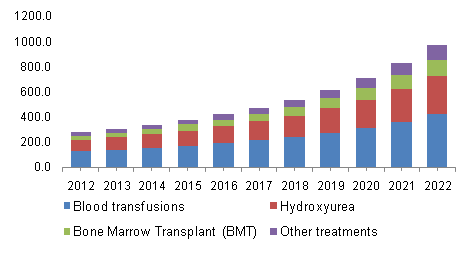Global hemoglobinopathies market is expected to reach over USD 8.82 billion by 2022 according to a new report by Grand View Research Inc. Rising prevalence of hemoglobin disorders such as sickle cell anemia, thalassemia, Hb C, and Hb E is estimated to be the high impact rendering drivers of the market. According to the WHO, hemoglobin disorders are endemic in over 60% of 229 countries affecting over 70% of births. It is also reported that minimum 5% of the world population are carriers of significant variation.
Prevalence of hemoglobinopathies is high in low-income countries such as Sub Saharan region and South East Asia. 85% of the affected population in the U.S. and Europe has ancestral base in these regions.
Governments are collaborating with local institutes to undertake awareness programs for curbing the effect of hemoglobinopathies-related mortality rate. For instance, Thalassemia Data Collection Project and Registry and Surveillance System for Hemoglobinopathies (RuSH) projects were started in 2010 by the Centers for Disease Control and Prevention (CDC).
Low level of hygiene, insufficient healthcare infrastructure, and lesser awareness levels are some key factors attributing to increase in base of target population in low-income regions such as South East Asia, Mediterranean basin, and Africa.
View
summary of this report @ http://www.grandviewresearch.com/industry-analysis/hemoglobinopathies-market
U.S. sickle cell disease market, by therapy, 2012-2022, (USD Million)

Further key findings from the study
suggest:
- The market for Sickle Cell Disease (SCD) was the largest with revenue valued at over USD 2,290.0 million in 2014. Rising prevalence of hemoglobinopathies and presence of strong product pipeline for sickle cell anemia such as HQK-1001 and Luspatercept are growth promoting factors of this market.
- Genetic testing for diagnosis of sickle cell disorders is expected to witness lucrative growth over the forecast period. It is estimated to grow at a CAGR of around 7.0%. Increasing awareness levels among people coupled with government programs such as the National Sickle Cell Disease Control Program conducted by the WHO in Africa are anticipated to enhance the usage rates for diagnostic tests pertaining to SCD.
- Hydroxyurea was one of the dominating segments of the SCD therapy market owing to the presence of the FDA-approved drugs such as Droxia and Hydrea by Bristol Myers Squib. SCD. Thalassemia market holds an extensive product portfolio in pipeline and their expected commercialization is anticipated to drive market growth. For instance, The Ellis Lab is developing a gene therapy for SCD in collaboration with Dr. Victor Garcia
- Blood tests including cell blood count and iron studies are the widely used techniques for diagnosis of thalassemia. On the other hand, pre-implant genetic testing is estimated to grow at lucrative growth rate over 8.5% in the next six years owing to rising base of health conscious population and increasing healthcare expenditure.
- The market for blood transfusion was the largest with revenues valued at over USD 1,408.0 million in therapeutic segment owing to, high acceptance level of this treatment option and significant success rate. It is estimated that around 85% of infants below five years suffering from thalassemia die due to insufficient blood transfusion.
- North America dominated the overall hemoglobinopathies market in terms of revenue in 2014 at over USD 1,212.0 million. Growing prevalence of blood disorders, favorable government programs, and high level of awareness among healthcare professionals and patients for hemoglobinopathies-related genetic testing are factors attributing to the major share of this market.
- Asia Pacific market is expected to witness lucrative growth over the forecast period with a CAGR of over 10% owing to the presence of high unmet clinical needs, improving healthcare infrastructure, and rising economic levels. Moreover, introduction of low-cost diagnostic alternatives will enhance adoption rates for hemoglobinopathies diagnostics market.
Browse All Reports of
this category @ http://www.grandviewresearch.com/industry/pharmaceuticals
Grand View Research has segmented
the hemoglobinopathies market on the basis of type, diagnostics, and
therapeutics:
Global Hemoglobinopathies Therapy
Outlook (Revenue, USD Million), 2012 – 2022
- Thalassemia
- Alpha thalassemia
- Beta thalassemia
- Sickle cell disease
- Hemoglobin variants diseases
Global Hemoglobinopathies Diagnosis
Outlook (Revenue, USD Million), 2012 – 2022
- Thalassemia
- Alpha thalassemia
- Beta thalassemia
- Sickle cell disease
- Hemoglobin variants diseases
Hemoglobinopathies Regional Outlook
(Revenue, USD Million), 2012 – 2022
- North America
- U.S.
- Canada
- Europe
- Germany
- UK
- Asia Pacific
- Japan
- China
- Latin America
- Brazil
- Mexico
- MEA
- South Africa
